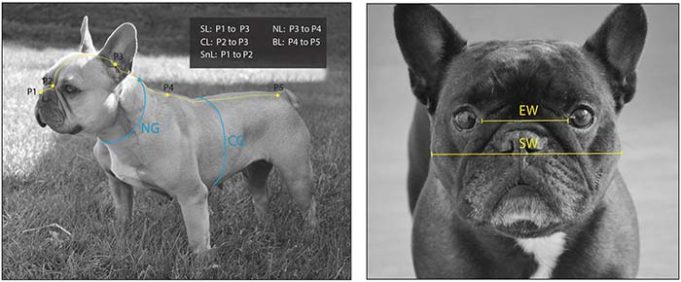Professionals are trying to find ways to predict breathing difficulties in short-nosed dogs in order to avoid certain traits while breeding.
Small-nosed canines such as pugs and French bulldogs are among some of the most beloved and adored pets today. But while these breeds are adorable, as many as half of them are afflicted with threatening breathing disorders, which is a direct result of the facial structure we have bred them to have.
Recently, researchers attempted to determine whether a dog’s breathing abilities could be accurately predicted by their outward facial features alone. They wanted to know if a healthy dog could throw any visible warning signs of eventually developing breathing issues later on in life.
According to their findings, there is no good way to determine this simply by looking at eternal features alone. This contradicts the results of a previous study conducted in 2015.
This is disappointing news for those attempting to “breed out” these disorders by avoiding key traits.
RELATED: Scientists Found Out Why Pugs, Boxers and Bulldogs Have Flat Faces
When Breeding Affects Breathing
Pugs and bulldogs are wildly popular. According to the Kennel Club, the French Bulldog is on its way to becoming the U.K.’s most popular pup to own.
But with their cuteness and popularity comes some baggage. That baggage is a condition called Brachycephalic Obstructive Airway Syndrome (BOAS), and it is a result of their head and facial structure, which is called brachycephalic morphology.

For more than half of the dogs with this condition, BOAS can lead to significant and negative health consequences, such as snoring, overheating, and difficulty exercising. In some cases, it can even be fatal.
So far, it has been impossible to stop this disorder’s prevalence, because symptoms usually do not arise until after the dog has started breeding. Because of this, veterinary scientists began looking for visual and physical clues in the dogs to try to start improving prediction of which dogs can be affected by BOAS later in life. The goal is to avoid breeding for traits which encourage or cause the disorder.
Previous Attempts Gave False Hope
In 2015, the Royal Veterinary College at University of London conducted a study looking at many breeds, whose conclusions stated that dogs with muzzles comprising less than half their head length and dogs with thicker necks had an increased risk for developing BOAS.
But this new study, conducted by the Department of Veterinary Medicine at the University of Cambridge, found that there is in fact no observed direct correlation between these physical features and the development of BOAS.
This current study took a look at over 600 pugs and bulldogs, studying measurements of heads and necks, body sizes and body conditions together with the appearance of nostrils, and graded each individual dog on their respiratory abilities.
While the team was unable to reproduce the findings from the 2015 study, they were able to find some predictive value in external head measurements, and more significantly, nostril size.

Because the dogs studied are constantly moving, it is very difficult to take accurate measurements of things like nose length or distance between eyes. Multiple measurements also mean having to combine several measurements from the same dog to find the real numbers. This may explain why replication of the 2015 results did not occur.
So, Which Features Can Be Predictive?
As it turns out, when a dog has large neck girth compared to their neck length or chest girth, this disproportion comes with a higher risk of BOAS in small-nosed breeds. For male dogs in particular, this is actually a strong predictor.
The most reliable trait turned out to be the size of the nostrils.

When all the variables measured were combined, they did give an 80% accuracy rate in predicting the development of BOAS in dogs.
“Dog breeders should also avoid using dogs with extremely short muzzles, wide faces, and thick necks.” – Nai-Chieh Liu
For now, Dr. Nai-Chieh Liu recommends breeding for larger nostril size, and thinner necks, longer muzzles, and more narrow faces.
Future studies will look at genetic testing which may help breeders rid BOAS entirely from these breeds.
The veterinarians’ best advice for owners of pugs and bulldogs? Get your dog checked out annually for breathing difficulties; these cannot always be observed easily. In addition, keep your dog active, and don’t let it get fat.
READ NEXT: French Bulldog Breed Profile
Reference:
- Nai-Chieh Liu, Eileen L. Troconis, Lajos Kalmar, David J. Price, Hattie E. Wright, Vicki J. Adams, David R. Sargan, Jane F. Ladlow. Conformational risk factors of brachycephalic obstructive airway syndrome (BOAS) in pugs, French bulldogs, and bulldogs. PLOS ONE, 2017; 12 (8): e0181928 DOI: 10.1371/journal.pone.0181928













